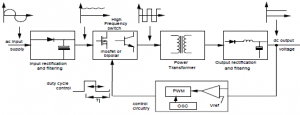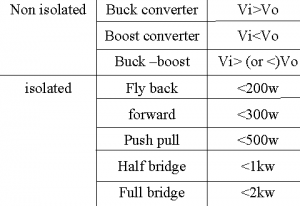What Is SMPS?
A switched-mode power supply (switching-mode power supply, SMPS, or switcher) is an electronic power supply that incorporates a switching regulator to convert electrical power efficiently D.C. to D.C. converters and D.C. to A.C. Converters belong to the category of Switched Mode Power Supplies (SMPS).
• SMPS stands for switch mode PSU. In such a device, power handling electronic components are continuously switching “on” and “off” with high frequency in order to provide the transfer of electric energy via energy storage components (inductors and capacitors). By varying duty cycle, frequency or a relative phase of these transitions an average value of output voltage or current is controlled. The operating frequency range of commercial SMPS units varies typically from 50 kHz to several MHz
Block Diagram of SMPS:
• The ac supply is first rectified, and then filtered by the input reservoir capacitor to produce a rough dc input supply.
• This level can fluctuate widely due to variations in the mains. In addition the capacitance on the input has to be fairly large to hold up the supply in case of a severe droop in the mains. S.M.P.S. can also be configured to operate from any suitable dc input; in this case the supply is called a dc to dc converter.)
• The unregulated dc is fed directly to the central block of the supply, the high frequency power switching section.
• Fast witching power semiconductor devices such as MOSFET and Bipolar are driven on and off, and switch the input voltage across the primary of the power transformer. T
• The drive pulses are normally fixed frequency (20 to 200kHz) and variable duty cycle.
• This voltage pulse train is appropriately rectified, and then smoothed by the output filter, which is either a capacitor or capacitor / inductor
Arrangement, depending upon the topology used
• This transfer of power has to be carried out with the lowest losses possible, to maintain efficiency.
• optimum design of the passive and magnetic components, and selection of the correct power semiconductors is critical.
• Regulation of the output to provide a stabilised dc supply is carried out by the control / feedback block.
• Generally most S.M.P.S. systems operate on a fixed frequency pulse width modulation basis, where the duration of the on time of the drive to the power switch is varied on a cycle by cycle basis.
• This compensates for changes in the input supply and output load.
• The output voltage is compared to an accurate reference supply, and the error voltage produced by the comparator is used by dedicated control logic to terminate the drive pulse to the main power switch/switches at the correct instance. Correctly designed, this will provide a very stable dc output supply.
• It is essential that delays in the control loop are kept to a minimum, otherwise stability problems would occur. Hence, very high speed components must be selected for the loop.
• In transformer-coupled supplies, in order to keep the isolation barrier intact, some type of electronic isolation is required in the feedback. This is usually achieved by using a small pulse transformer or an opto-isolator, hence adding to the component count.
• In most applications, the S.M.P.S. topology contains a power transformer. This provides isolation, voltage scaling through the turns ratio, and the ability to provide multiple outputs. However, there are non-isolated topologies.
SMPS TOPOLOGIES:

